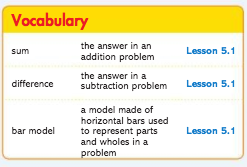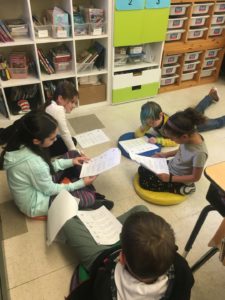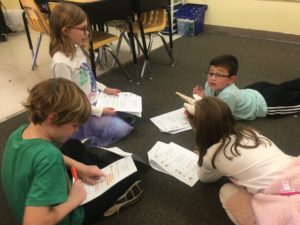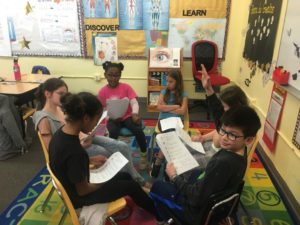by Jill & Sarah | Nov 23, 2019 | 2nd/3rd Grade News
La Lectura
Thank you for coming to share the Thanksgiving play with us! They were all so excited to be able to perform for you! We hope you have a wonderful Thanksgiving break next week and are able to compare and contrast your own Thanksgiving traditions with the first Thanksgiving and with Susy’s family.
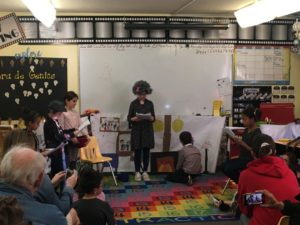
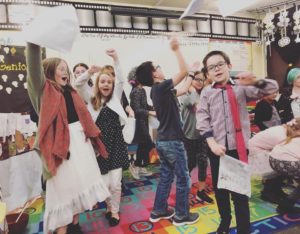
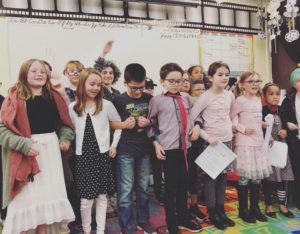
Please be sure to have the kiddos continue to ready daily during their week off. I have asked them to record their reading 3 times during the vacation. (Record in kidsa-z.com)
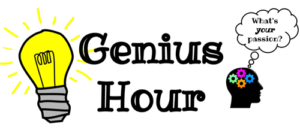
I’ve sent the Genius Hour folders home with the kiddos and asked them to start working on any props they plan to use during their presentation. Any posters or text should be done in Spanish. (Please note: there is no actual due date for their presentation. This is an open-ended project where kiddos are researching and planning at their own pace.)
Las Matemáticas
2nd / 3rd Graders will be more successful in our next unit of study if they start already comfortable with their Multiplication Facts 0-5. Here are some fun and helpful links:
Multiplication Fact Practice (0-5):
Science
We are finishing up our Ancient Rome unit and will start a new science unit when we return from Thanksgiving break.
We also worked on a personal essay about things we are thankful for. We focused on paragraphs with topic sentences and supporting details.
History & Geography
This week our objectives were to be able to:
- Explain what the Temple of Jupiter is and the significance of its location in Rome.
- Describe the activities that took place in Rome´s markets and the Forum.
- Understand the meaning of the following vocab: gladiator and marble.
- Recognize the Colosseum and understand its structure.
- Describe how the Colosseum was used.
- Describe the structure and uses of the Circus Maximus.
- Understand the meaning of the following vocab: Colosseum, arena, and chamber.
Character Education
During the month of November we have been focusing on Gratitude and what that means to us. We have talked about expressing our thanks when others offer us things (not asking if there is more or a different kind of the offered item). We have talked about being grateful for the time others spend with us, for the love of our families and friends, for the shelter provided to us at home and school, and for the food we eat. We talked about how not everyone has these things and how easy it is for us to take these things for granted. Sometimes it’s important to stop and think about all the wonderful people, things, and opportunities we have in our lives. Thanksgiving is the perfect time to reflect on these things and to give our thanks.
In the month of December we will be focusing on generosity. We have already spoken about being generous with our time, our words, our actions and our resources. Our tradition at SWS is to demonstrate generosity through a charitable organization. This year we are collecting gifts for the YWCA Family Shop, which allows families in need to shop for free. Tags can be picked up on the SPA bulletin board. It would be great if you could include your child in this process. All items need to be returned to the school by December 16th.
Art with Ms. Kelly
Fall Still Life (continued from October)
Our goals were:
- Observe real fruits and vegetables
- Use overlapping to create depth
- Add color and texture with tissue paper and water
Henri Matisse Collages
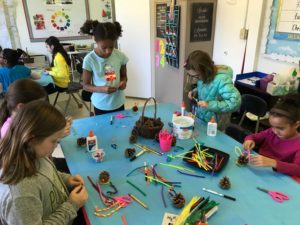 Our goals were:
Our goals were:
- Learn about the French artist Henri Matisse
- Look at a variety of his artwork
- Read Drawing with Scissors by Keesia Johnson and Jane O’Connor
- Make a collage by cutting out shapes (without drawing them!)
The students did an amazing job cutting out birds, stars, flowers and leaves to create a collage in the style of Henri Matisse.
Pinecone turkeys
- Use sticker foam to draw and cut out turkey features
- Make turkey “feathers” from pipe cleaners
- Learn about the difference between paintings and sculptures
The students created a variety of very colorful, fun turkeys! I hope you enjoy these during the
Thanksgiving Holiday!
by Jill & Sarah | Nov 16, 2019 | 2nd/3rd Grade News
La Lectura
 We would like to invite parents to come see our Thanksgiving Play on Friday, November 22nd at 2:30. The play is divided into three parts and students are encouraged to dress their ‘part’. They can practice reading at home (and count this toward their reading minutes).
We would like to invite parents to come see our Thanksgiving Play on Friday, November 22nd at 2:30. The play is divided into three parts and students are encouraged to dress their ‘part’. They can practice reading at home (and count this toward their reading minutes).
This week we have really continued to focus on our reading strategies with the Thanksgiving play. We have worked on word identification, cause & effect, inference, and visualization.
Please be sure to have your child continue to read at home, using their bookmark to help them with comprehension strategies.
Las Matemáticas
We completed our 4th unit of study, subtraction to 10,000, with a chapter test. The students did a great job and are ready to move on to our next (super short) unit of study: Bar Models.
Math in Focus Chapter 5: Using Bar Models: Addition & Subtraction
Big Idea: Using bar models to solve 2-step real-world problems involving addition and subtraction.
- Apply the part-whole concept in addition and subtraction to numbers to 10,000
- Use strategies, such as adding on and taking away sets represented by bar models, to add and subtract
- Compare two sets using bar models
|
Key Visuals/Activities:
- Use of bar models & what they represent
- Use bar models to solve 2-step real-world problems involving addition and subtraction
|
Chapter Vocabulary: sum, difference, bar model
|
|
Lesson of the week:
- 5.1: Real-World Problems: Addition and Subtraction
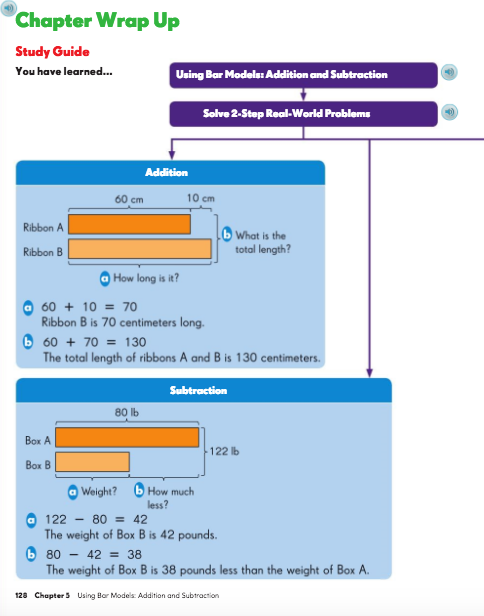
|
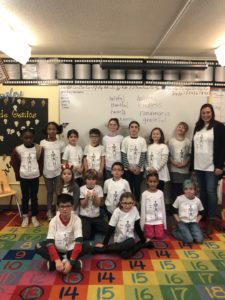
Sporting our skeleton t-shirts last week.
History & Geography
This week our main objectives were to:
•Locate the Roman empire on a world map
•Identify the countries that occupy the area today
•Identify the dominant nature features of the Roman empire
•Understand the meaning of the following domain – specific vocabulary: continent, mountain range, strait, and kingdom
•Describe ancient Rome as a crowded and busy city
•Explain what the temple of Jupiter is in the significance of its location in Rome
•Describe the activities that took place in rooms markets and the Forum
by Jill & Sarah | Nov 9, 2019 | 2nd/3rd Grade News
La Lectura
This week we introduced a Thanksgiving reader’s theater. We will use this drama to focus on our reading strategies throughout the month of November. We will most likely be performing this drama on the last Friday of school before our Thanksgiving vacation begins. Look for more information coming home soon. (We might ask for parents to contribute to a class feast.)
We have continued to work on:
- visualizing as a reading strategy
- summarizing what we have read (ask your child to retell they stories to you, in their own words)
- identifying main ideas and supporting details
- identifying cause and effect
- FLUENCY: covering parts of words to help us pronounce them better, using context clues to help us understand new word meanings, identifying parts of words we know
Please be sure to have your child click on the book icon (in www.kidsa-z.com
Las matemáticas
Math in Focus Chapter 4: Subtraction Up to 10,000
Big Idea: Subtraction up to 10,000
- Greater numbers can be subtracted with or without regrouping
- Students learn the part-whole concept, and the addition and subtraction of numbers up to 10,000
|
Key Concepts:
- Subtraction of numbers with or without regrouping up to 10,000
- Subtract 4-digit numbers with or without regrouping
- Solve real-world word problems involving subtraction of 4-digit numbers
|
|
|
Lessons:
- 4.1: Subtraction without Regrouping
- 4.2: Subtraction with Regrouping in Hundreds and Thousands
- 4.3: Subtraction with Regrouping in Ones, Tens, Hundreds, and Thousands
- 4.4: Subtraction Across Zeros
|
History & Geography
This week we spent time reviewing previous lessons and catching up on lessons we didn’t get to last week
by Jill & Sarah | Nov 2, 2019 | 2nd/3rd Grade News
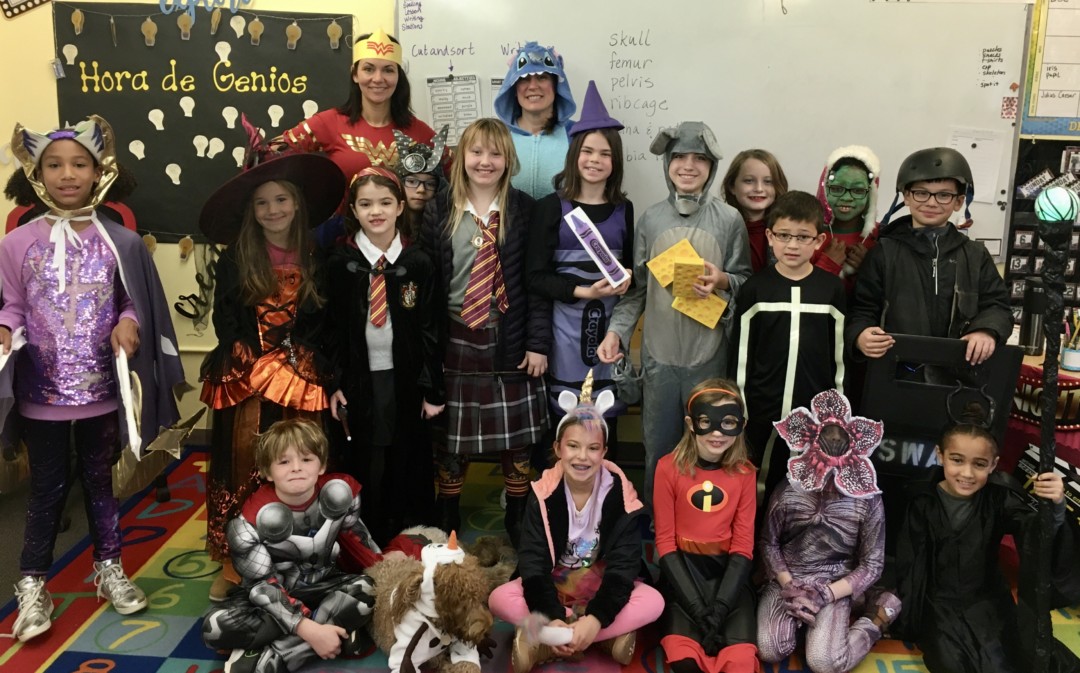
La Lectura
We have really been focusing on our reading comprehension strategies and would love for you to help reinforce these at home during your child’s nightly reading. Remember: reading is the number one most important thing for your child! They should be reading aloud every single day in both English and Spanish. We don’t give much other homework in order to make sure you have time for reading.
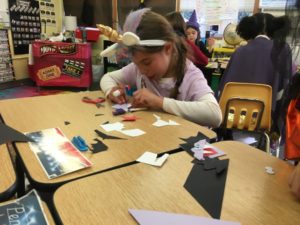
Creating an origami-vampire bookmark.
7 Reading tips for home:
When kids connect what they already know to what they read, it helps them focus. Show your child how to make connections when you read aloud. If a book mentions places you’ve been to with your child, talk about those memories. Then have your child give it a try.
Asking questions encourages kids to look for clues in the text. When you read together, ask questions to spark your child’s curiosity. Ask things like “What do you think will happen?” or “How is that character feeling?”
Visualizing helps bring a story to life. That’s where mind movies come in. When you read with your child, describe what the scene looks like in your head. Talk about how it makes you feel. You can use other senses, too. For example, if the scene takes place outside, what does it smell like? Then invite your child to make a mind movie, too. Point out how your child’s movie is different from yours. If your child likes to draw or color, encourage your child to make a picture of the scene, too.
When you combine what you already know with clues from a story, you can make guesses or predictions. These are inferences. And making them is a great way to build reading comprehension.
For example, when we read “Kim’s eyes were red and nose was runny,” we can infer that Kim has a cold or allergies. Help your child do this as you read. If a character is wearing gym clothes and sweating, ask your child what the character might have been doing before.
5. Figure out what’s important.
Ask your child: Who are the main characters? What’s the most important thing that has happened in the story so far? What problem are the characters trying to solve? When kids can point out what’s important, they’re more likely to understand what they read.
Your child can also use a tool called a graphic organizer to do this. A “story element” organizer keeps track of the main characters, where the story is taking place, and the problem and solution of the story.
It helps to encourage kids to stop and ask themselves, “Is this making sense?” If your child gets stuck, suggest rereading the part that didn’t make sense. What about it was confusing? Were there specific words that tripped your child up?
The more kids know about the world, the more they can get meaning out of what they read. You don’t have to take an expensive trip or go to a museum to do this, though. You can expand kids’ background knowledge and vocabulary in lots of ways.
Shooting hoops or watching a baseball game can help your child connect more with books about sports. Riding the subway might make your child interested in books that take place in big cities.
SPELLING
We art starting a new, more meaningful, method of spelling. We are refocusing on specific parts of words, to help us in our reading and writing. Your child brought home a new (shorter) list of words on Tuesday. They can put the list in alphabetical order (on the right side of the page) and turn it in on testing day (Friday, November 8th) for a bonus point on their spelling test. Why? Looking at the ABC order will help them dig into the words, comparing their spelling.
We will be doing several activities with the spelling words during the 2-week period, including word sorts. Your child brought home an orange word sort on Friday. They should use these to practice their spelling words. Comparison of words helps us to look at them more carefully.
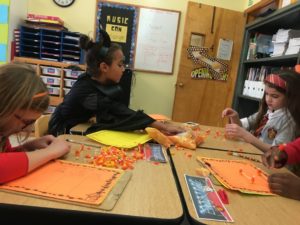
Halloween math and stem projects.
Las matemáticas
We completed our unit on addition to 10,000 with a test on Monday. Everyone did great! We made time on Tuesday for the students to make any corrections to their test, with most of them realizing they made very simple/silly errors. We need to learn from our mistakes!
We will continue taking the addition 2-minute timed tests but we have also added in the 2-minute subtraction tests. Our new unit is subtraction to 10,000. Skill and drill with flashcards at home is VERY helpful! Students are making the connections between addition and subtraction and we are really looking for automaticity! Mastery of these skills is very important as we will be building upon them in each unit throughout the year.
Science
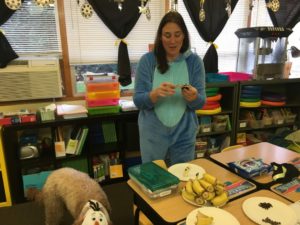 Our objectives this week were to:
Our objectives this week were to:
• Explain that the five senses work with the brain to process information about our surroundings
• Identify the surrounding parts of the eye: eyesockets, eyebrows, eyelids, and eyelashes
• Identify the outer parts of the eye: Sclera, cornea, iris, and pupil
• Identify the inner parts of the eye: lens, retina, and optic nerve
• Explain how the parts of the outer and inner eye work together with the brain to allow a person to see
• Describe nearsightedness and farsightedness and how these can be corrected
• Identify the outer parts of the year: ear flap, ear lobe, ear canal, and eardrum
• Identify the middle parts of the air as the three ear bones: hammer, anvil, and stirrup
• Identify the inner parts of the year: cochlea and auditory nerve
History & Geography
Our goals this week were to:
• Explain why ancient Rome was considered a civilization
• Identify and locate on a map the following areas: France, Spain, England, Germany, North Africa, and Egypt
• Describe the life and contributions of Julius Caesar
• Identify some of the contributions of the ancient Roman civilization, and describe how they have influenced the present
• Describe the role of Cleopatra of Egypt in the ancient Roman civilization
• Explain the significance of the Pax Romana and how it affected the life of Romans
Specialists
Art with Ms. Kelly
Apples Paintings
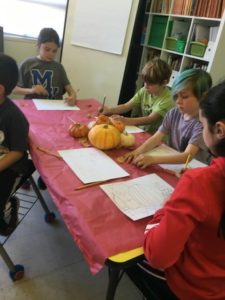 Observe shape, color and texture of real apples
Observe shape, color and texture of real apples- Learn about our state’s apple orchards
- Look at Paul Cezanne’s paintings of fruit
- Draw overlapping apples on a plate (aerial view) or in a bowl (side view)
- Use only red, blue, yellow and white to mix a variety of colors
- Each class from K through 4th/5th made stunning apple paintings!
Leaf Art
- Observe shape, color and texture of autumn leaves
- Make texture rubbings of leaves
- Use leaves for stencils and stamping
- Make rubbings of Ginkgo leaves
Owl Guided drawing
- Use shapes and pattern to draw an owl
- Learn about warm and cool colors, and how to mix brown
- Use watercolor techniques
- Listen to Owl Moon by Jane Yolen
- These beautiful owls are on the bulletin board at school!
Pumpkin Drawings and Still Life
- Observe real pumpkins and fruits
- Learn how to use chalk pastels
- Create a fall still life picture using crayon and tissue paper
We’ll continue these colorful still life projects in November.
Music with Ms. Nadia
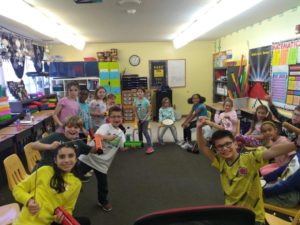 Wow, has it been two months already?! This month flew by as we learned about Solfege, dynamics, and Aaron Copland.
Wow, has it been two months already?! This month flew by as we learned about Solfege, dynamics, and Aaron Copland.
Solfege, a fancy word for the musical system of “do ra mi”, is a useful tool to learn melody. As a group, we played melodies with pitched percussion instruments (boom-wackers and the glockenspiel), while keeping the beat with our non-pitched percussion instruments (clave, shakers, triangle, etc.). Other games and hands-on activities made learning fun, such as Solfege Charades, Solfege Finders, the Solfege Songwriting Challenge, and Do a Deer (hand-motion style).
Aaron Copland was composer in the early 20thcentury who composed such masterpieces as Appalachian Spring and Rodeo, both of which were written as ballets. In a game of Two Truths and a Lie, we learned that Aaron Copland started composing at age 11, studied in Paris for a few years, and had an amazing teacher named Nadia (Nadia Boulanger)! We drew art to his music, learned the words to Simple Gifts (from the seventh movement of Appalachian Spring), changed the words to Simple Gifts in a game of mad-libs, passed a bear around hot-potato-style to Rodeo, and let our imaginations run wild! His compositions feature a wide range of dynamics from his piano legato (soft and smooth) introduction in the first movement of Appalachian Spring to the forte staccato (loud and choppy) second movement. I encourage everyone to listen to Appalachian Spring at home; it’s a wonderful way to start the morning or wind down a long day!
Character Education

Teamwork and collaboration proved to be the most helpful in our Class-wide blanket fort.
by Jill & Sarah | Oct 26, 2019 | 2nd/3rd Grade News
La Lectura
This week we are really focusing on our reading fluency, what this means, and how we can improve it as a whole class.
The Common Core State Standards, adopted by most states, require third-grade students to “read with sufficient accuracy and fluency to support comprehension.” Children must balance punctuation cues, phrasing, pace and expression to develop reading fluency. They also need to acquire a strong base of sight words. When students can read smoothly and accurately, and they transfer the skill to silent reading, comprehension increases.
All students were assess on 169 Spanish sight words and they all did a fantastic job! They know them very well! Now we are continuing to work on our reading strategies, identifying main idea and supporting details. I am finding the online reading (where they record their Spanish reading) very helpful. Please try to have your child read aloud each day and do at least one recording on the site each week.
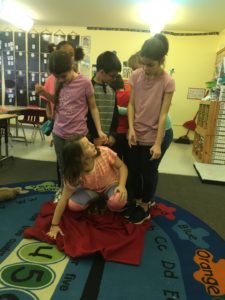
Teamwork: cooperation makes tasks possible in this ‘flip the blanket’ activity.
Las matemáticas
We have completed our addition within 10,000 unit and will add in subtraction next week. We have continued to have our daily 2-minute timed tests for addition. Students are doing very well! (Please get those flashcards out if your child comes home with a test below 45 correct.)
This week we practiced making our own addition word problems. Understanding how to make the story problems is very helpful when they read other problems.
I’d love for the students to bring their Halloween candies to school next Friday so we can use them to make some more addition and subtraction stories. This will be fun!
Science
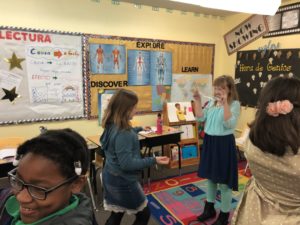
An experiment with reflexes. Learning about our nervous system.
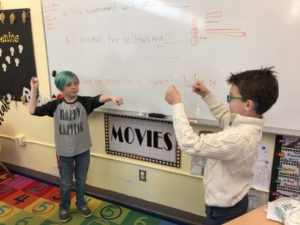
Our main goals this week were to:
- Explain that one of the systems of the human body is the nervous system and identify its function
- Identify the brain and spinal cord as the control center of the body
- Identify nerves as messengers that transmit information from all of the parts of the body through the spinal cord to the brain
- Explain that the five senses work with the brain to process information about our surroundings
- Describe a reflex action as a quick, unconscious action and explain its purpose in protecting the human body
- Identify parts of the brain: brain stem (medulla, cerebrum and cerebellum
- Describe the human brain as divided into two hemispheres
History & Geography
This week our objectives were to:
- Explain why Rome was considered a civilization
- Compare and contrast the three categories of people in ancient Rome: patricians, plebians, and slaves
- Describe the evolution of government in ancient Rome: monarchy to republic to empire
- Describe the senate as part of the government of the Roman Republic
- Describe the importance of forums in Roman society and government
- Identify some of the contributions from the ancient Roman civilization
- Identify and locate on a map the following: Mediterranean Sea, Italy, Sicily, North Africa, Carthage, Spain and the Alps
- Explain the significance of the Punic Wars
- Describe the role of Hannibal in the Punic Wars
by Jill & Sarah | Oct 19, 2019 | 2nd/3rd Grade News
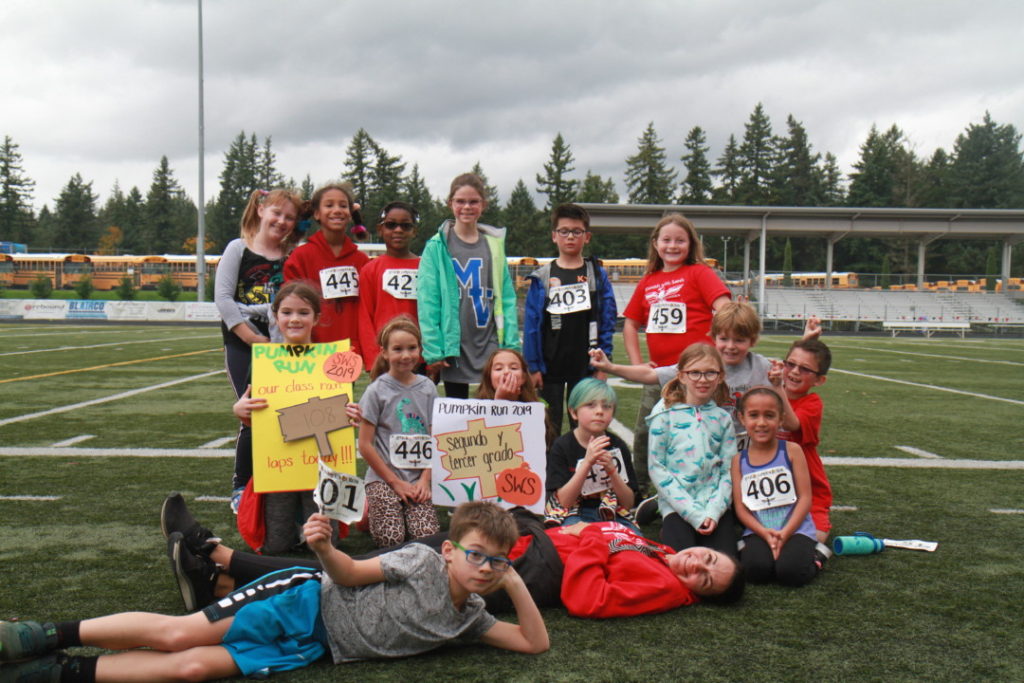
La Lectura
Students received their new spelling list. The spelling test will be next Friday, October 25th. We created a class book with this list of spelling words. Each student illustrated and wrote a sentence for one word and then we combined them and made copies. (Some kiddos needed to write a little darker for the copier to pick up so we traced over words.)
Students also received a new reader this week. They should be reading in Spanish on a nightly basis but I know this can sometimes be difficult. To help with this, I have created class logins on kidsa-z.com. They can read a book aloud, while the computer records their reading. I will be able to listen to each student, keep a running record, ask comprehension questions, and move them along to the appropriate level. We will be creating a class chart for progress minutes to help encourage them to read in Spanish. (Any Spanish reading counts towards this.) I’m pretty excited about this, as finding something new to read in Spanish has been a continual question from families. I sent home a parent information sheet on Thursday. If you would like to receive email updates, please fill out the bottom of the form and return it.
We also did some identification of topic sentences in paragraphs and discussed how this is important when reading AND when writing.
We added the letter J to our cursive skills.
Reading
On Thursday I sent home a new source for Spanish reading: www.kidsa-z.com Your child has the same username and password as Prodigy. This site has hundreds and hundreds of Spanish (and English) readers. Students took a placement test on Thursday and will be placed at the correct level as I work through them this weekend. This is a GREAT online resource because:
- It puts hundreds of Spanish (and English) books in your child’s hands.
- It allows your child to read at the appropriate level.
- It records your child’s reading so I can listen and keep a running record to help place them in the appropriate level.
- It asks comprehension questions, to make sure your child is understanding what they are reading.
Please let me know if you have any questions about this. (It is not mandatory to use this online system but is useful to help get that nightly Spanish reading in.)
Las matemáticas
This week we jumped right into our new math unit: Addition to 10,000. Students showed great understanding of addition with and without regrouping. To help them be more efficient mathematicians we have paused our multiplication timed tests and started doing addition timed tests. If your child is not passing their addition timed tests each day please be sure to get out the flashcards. Addition facts should be automatic. Students are given 2 minutes to complete 50 basic addition facts each day. Their addition skills directly affect their ability to move smoothly through our math lessons.
Science
Our science objectives this week were to:
- Describe and/or review seven of the systems of the human body
- Explain that the human body includes the following systems and identify the function of each: skeletal, muscular, and nervous
- Identify cells as the basic building blocks of all living things and explain that most cells are too small to be seen without a microscope
- Explain the relationship between cells, tissues, organs, and systems
- Explain that each system is made up of different types of cells (bone cells, muscle cells, nerve cells, blood cells, etc.)
- Recall there are 206 bones in the human body
- Identify examples of axial bones and explain their functions
- Explain briefly the composition of bones
History and Geography
This week we started a new unit: The Ancient Roman Civilization. Our objectives were to:
- Explain why Rome was considered a civilization
- Identify and locate on a map the following areas: Atlantic Ocean, Mediterranean Sea, Black Sea, Aegean Sea, Europe, Italy, Rome, Pompeii, Mount vesuvius, Greece, France, Spain, England, Africa, Asia, and Turkey
- Locate the Bosporous Strait and the Strait of Gibraltar, and explain the purpose of these waterways
- Identify Rome as the capital of present-day Italy
- Identify the country of Italy as a peninsula
- Define the terms BC/BCE and AD/CE
- Describe how the work of archaeologists has helped us gain info about the ancient Roman civilization
- Identify some of the contributions of the ancient Roman civilization
by Jill & Sarah | Oct 12, 2019 | 2nd/3rd Grade News
La Lectura
This week we read the story Rugby y Rosy. This is a great story about two dogs getting used to each other and then one dog leaving to go into training and then work as a seeing-eye service dog. Our learning objectives this week were to:
- identify and use helping verbs in sentences
- identify varying sentences formats and create our own
- read fluently as a whole group, in pairs, and individually
- write cursive letters Ss and Pp
- Test on spelling words with H (a silent letter in Spanish).
- Add to their autobiography timeline
Next week we will have a special guest on Tuesday. Joy Ross is a local mom and YouTuber who went blind 12 years ago. She will come in to share her experience with her first and second guide dogs.
Las matemáticas
We worked on front-end estimation to see if our calculations are reasonable answers or not. We identified the dígito principal in vary8ing numbers in order to correctly estimate. We then completed our unit on Mental Math with Rounding. Students were tested in a non-traditional format: on prodigy.
Our next unit will be on addition facts up to 10,000. Students should be beyond using their fingers at this point! We will bring back out some addition timed tests to check their fact fluency. Flashcards are always helpful if your kiddo needs a refresher.
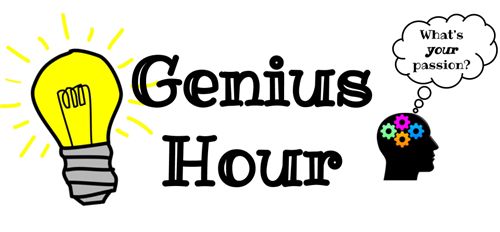
This week we spent our time researching and taking notes on that research. Students are encouraged to properly document when they find information outside of school too.
Science
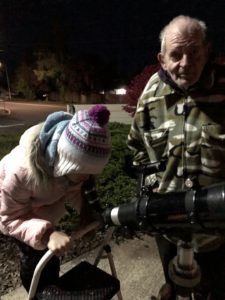

- Describe tools and methods used to study space and share information
- Identify and use vocabulary important to the process of science
- Describe the life and contributions of Mae Jemison
What an amazing night we had viewing the moon, Jupiter and Saturn! Thanks for braving the cold and coming out to view our solar system!
History & Geography
- Explain how rivers help people trade with each other
- Understand the meaning of the following vocabulary: toll, network, canal
Character Education
Continuing with our Teamwork and Cooperation theme we discussed how they had used cooperation in school during the last week and at our Field Trip.
Students also practiced their cooperation skills to recreate scenes from last week’s cooperation video.
The class was also given the task to cooperatively get an exercise ball from one side of the room to the other, with every student touching the ball at some point, no hands, and the ball could not touch the floor. It was very interesting to see and hear the cooperation! Bossing does NOT equal cooperation! They were successful using two different methods!
by Jill & Sarah | Oct 5, 2019 | 2nd/3rd Grade News
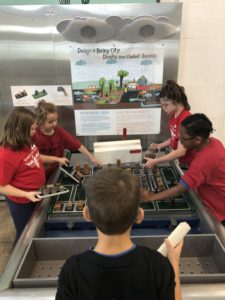
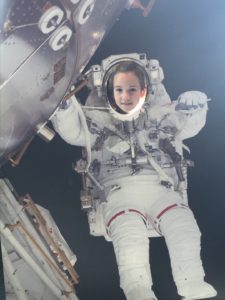
Fun and exploration at OMSI!
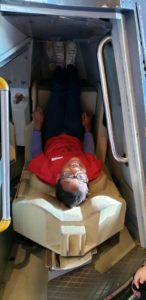 Change of Date for our class dress-up. We will dress up as our favorite Disney Movie on THURSDAY, October 17th.
Change of Date for our class dress-up. We will dress up as our favorite Disney Movie on THURSDAY, October 17th.
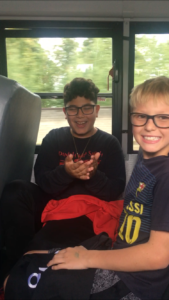 La Lectura
La Lectura
This week we read a fun story title “Rugby and Rosy”. Our objectives were:
- understand what auxiliary verbs are (please see our fall verb trees in the hallway)
- use comprehension strategies such as making connections, visualizing, and self-questions to construct meaning from the story during our first read
- summarize main ideas and important details
- Identify topic sentences in paragraphs
Students also received their new spelling list and will be tested on October 10th (there is no school on Friday, 10/11.)
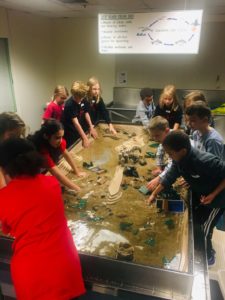 Las matemáticas
Las matemáticas
Students really came through and showed mastery of rounding in their Prodigy accounts. They were also able to demonstrate these skill in class during our notebook time, games, and through worksheets. Our math goals this week were:
- to use mental math
- Use different strategies to add 2-digit numbers close to 100 mentally
- Round numbers to estimate sums and difference
- Use front-end estimation to estimate sums and differences
- practice multiplication skills with 3-minute tests (Flashcards really help if your child is stuck on certain numbers!)
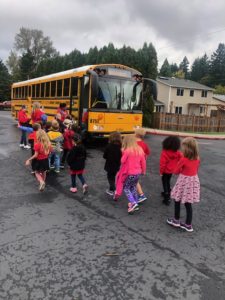
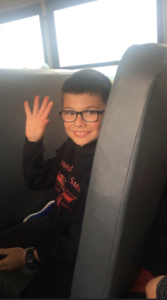
Science
This week our objectives were to:
- Explain that Pluto has been reclassified as a dwarf planet
- Describe the effects gravity has on Earth
- Describe tools and methods used to study space and share information
- Describe the life contributions of Copernicus
- Recall key details about the history of space exploration
History & Geography
Our objectives were to:
- Explain how rivers help people trade with each other
- Understand the meaning of the following vocabulary: toll, network, and canal,
- Explain how rivers provide good habitats for wildlife
Character Education
This month we will continue to add ribbons to our school Kindness Wreath but we will now focus on Teamwork and Cooperation. We will be doing many great activities to show the importance of how communication and cooperation make teamwork so much better! We encourage you to point out how everyday tasks at home are made easier with a little bit of teamwork.
by Jill & Sarah | Sep 28, 2019 | 2nd/3rd Grade News
La Lectura
This we read a great story about two neighbor girls who build “competing” tree houses. They learned the lesson that they would enjoy their lonely treehouses more if they shared them with each other. This story provided a great opportunity for us to work on our comparing and contrasting skills. Our weekly objectives were:
- to test on spelling words with Z.
- to compare and contrast details from a story.
- to identify cause and effect.
- to use context clues to help us identify unknown words.
- to read aloud with a partner *and use context clues to help with comprehension.
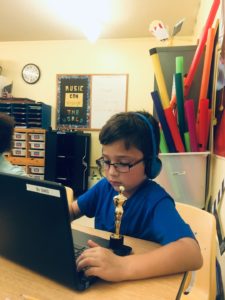
The Week 3 Reading award was well received! (And coveted, even during Prodigy practice.)
Las matemáticas
This week was all about multiplication facts (through our 3-minute tests), mental calculation and rounding!
I have challenged your children to complete the rounding section of Prodigy before Monday. We have completed several fun and meaningful tasks to help them better understand numbers on a number line and how to use them for rounding. Can’t wait to see how everyone stacks up on Monday! Class tickets are on the line for this challenge!

Students have finalized their question and moved into the actual research. They can bring in books or take notes from books/videos/interviews at home. To be clear, they do not need to complete any of this project at home but they are welcome to continue their research if they want.
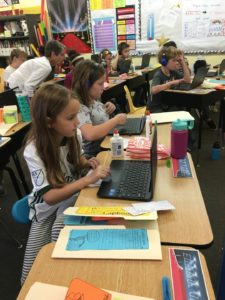
Research has begun! We’ve added a few more times to our Genius Hour lap books.
Science
This we our objectives were to:
- Identify the Andromeda Galaxy as the closest spiral galaxy in our universe.
- Describe gravity
- Describe the effects gravity has on Earth, within the solar system, and in the universe.
- Describe the characteristics of stars
- Compare and contrast our sun and other stars
- Describe a galaxy as a very large cluster of many stars
- Explain what constellations are and how they are useful
- Recognize and name important constellations in the hemisphere in which you live
History & Geography
A huge thank you to Mr. Brian for coming in to our classroom on Friday and sharing his experience as a tugboat captain and ship pilot on the Columbia! This was such an interesting and informative presentation relating to using rivers for transportation.
This week our goals were to:
- List three dangers that boat captains must look out for on rivers
- Describe the dangers on the Mississippi River and the Ob River
- Describe the locations of the Mississippi River and the Ob River
- Understand the meaning of the following domain-specific vocabulary.
Music with Ms. Nadia
Music is a great way to get the wiggles out and learn something new! This month we learned about rhythm through tapping sticks, hitting drums, striking triangles, clicking claves, shaking maracas, sliding sandpaper blocks, and jingling jingle bells. We were introduced to quarter and eighth notes and quarter rests, which we played in patterns on the percussion instruments. We also read a book called Max Found Two Sticks about a boy who saw music in the world around him. The kids followed along by repeating the rhythms in the story.
Some of my favorite moments of class are when students’ suggestions become a reality. The past week we went on a repeat-after-me Bear Hunt song adventure in which we ended up chopping down a tree to cross a river, riding an old abandoned railway car over a canyon, and running through a fossil museum. It was quite the experience! This class abounds with creativity and gusto which makes it fun to sing with them each week!
Art with Ms. Kelly
I’m enjoying working with this fun and creative class!
The first week we reviewed our Art Class procedures and rules, and then each student made an Abstract Name Design using markers and crayons. We looked at the artwork of the American artist Stuart Davis who used lots of letters and numbers in his abstract paintings during the 1940’s and 1950’s. 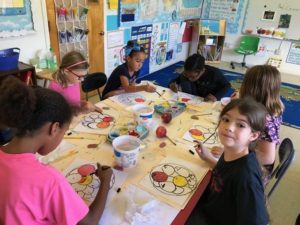
The students learned about Roman Mosaics for our next project. We looked at examples of ancient Roman mosaics made from tiles, rocks, and glass. Ms. Laura, who helps out each Wednesday in Art, brought in a beautiful hand-made mosaic clock for the students to see. The students then used a variety of papers to cut out their own “tiles” to make a mosaic fish. Their wonderful “Modern Mosaics” are on the bulletin board at school.
We welcomed the season of Fall by learning how to draw and paint a “birds-eye view” of a plate of apples. The students learned about Still Life, and the artist Paul Cezanne. Their gorgeous apple paintings will be finished next week!







